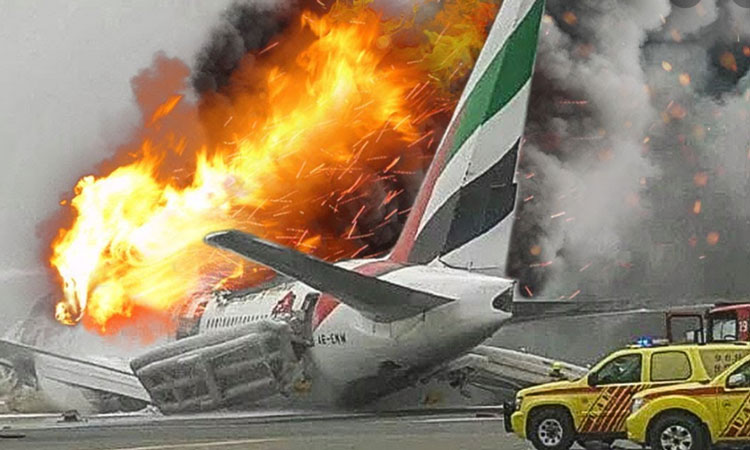Two-tier fire protection: Are we facing a false sense of security?
- Like
- Digg
- Del
- Tumblr
- VKontakte
- Buffer
- Love This
- Odnoklassniki
- Meneame
- Blogger
- Amazon
- Yahoo Mail
- Gmail
- AOL
- Newsvine
- HackerNews
- Evernote
- MySpace
- Mail.ru
- Viadeo
- Line
- Comments
- Yummly
- SMS
- Viber
- Telegram
- Subscribe
- Skype
- Facebook Messenger
- Kakao
- LiveJournal
- Yammer
- Edgar
- Fintel
- Mix
- Instapaper
- Copy Link
Posted: 18 December 2020 | Mike Willson (Fire Protection Consultant) | No comments yet
Mike Willson, firefighting foam and foam systems specialist, examines whether the two-tier fire protection system developing at some of our key airports is potentially affecting the safety of passengers, flight crews, emergency responders and other stakeholders.


How well are we being protected when we travel? Are we facing a false ‘sense of security’ from approval standards which may not seem focused on addressing worst-case scenarios? Could a post-COVID-19 world encourage more transparency, with approval modifications to improve fire safety, by addressing these issues?
Fear of continuing PFAS contamination seems unjustified
Regulatory pressures and fear of historic Perfluoroalkyl and Polyfluoroalkyl Substances (PFAS) contamination principally derived from legacy long-chain C8 foams discharged during repeated extensive firefighter training at specific locations, seem to be driving a change. Even though firefighter training is now generally tightly controlled, it often uses Fluorine Free Foams (F3s) with all discharges normally regulated to be contained, collected, treated and disposed of safely. It seems primarily designed to prevent environmental discharges, not necessarily to prevent life loss. Are we driving these decisions down a specific F3 path, despite concerns it may not be in the long-term safety interests of travellers, flight crews, firefighters, airlines, airport reputations, or indeed regulators themselves? International Civil Aviation Organisation’s (ICAO) Level B and C fire tests were extended from 60 seconds to 120 seconds extinguishment in 2014. But why? When every second counts in saving lives.
How well are we being protected when we travel? Are we facing a false ‘sense of security’ from approval standards which may not seem focused on addressing worst-case scenarios? Could a post-COVID-19 world encourage more transparency, with approval modifications to improve fire safety, by addressing these issues?
Fear of continuing PFAS contamination seems unjustified
Regulatory pressures and fear of historic Perfluoroalkyl and Polyfluoroalkyl Substances (PFAS) contamination principally derived from legacy long-chain C8 foams discharged during repeated extensive firefighter training at specific locations, seem to be driving a change. Even though firefighter training is now generally tightly controlled, it often uses Fluorine Free Foams (F3s) with all discharges normally regulated to be contained, collected, treated and disposed of safely. It seems primarily designed to prevent environmental discharges, not necessarily to prevent life loss. Are we driving these decisions down a specific F3 path, despite concerns it may not be in the long-term safety interests of travellers, flight crews, firefighters, airlines, airport reputations, or indeed regulators themselves? International Civil Aviation Organisation’s (ICAO) Level B and C fire tests were extended from 60 seconds to 120 seconds extinguishment in 2014. But why? When every second counts in saving lives.
Evidence is building to suggest more caution may be necessary to better protect lives, critical infrastructure and our environment from potential unintentional harm, as significant differences are being highlighted between F3s and C6 foams by extensive comparative research testing and major incidents. Testing is focused at small-scale, not the large-scale verification fire tests essential to validate fire performance under more challenging and realistic conditions. Could this prevent substitution regrets from hasty changes away from proven C6 reliability? Perhaps major incidents are exposing weaknesses not seen since before aqueous film forming foams (AFFF) development.
Surprising outcomes from two major incidents
A dramatic contrast was evident after a major 2016 Boeing 777 engine detachment fire in Dubai under severe 48°C wind shear conditions. The air crash investigation report confirmed F3 was used but gave no explanation why the plane burned for 16 hours.
Remarkably all 282 passengers were evacuated six minutes after the crash. Three minutes later a fuel tank exploded tragically killing a brave firefighter. Seconds count to save lives, but this could so easily have been a much greater tragedy.
Might faster C6 fluorinated foams have saved this life? Absence of PFAS in the foam also seems to have failed to prevent aircraft destruction and significant PFAS escaping to the environment from seating, carpets, screens, computer systems etc. as the plane burnt out.
In Singapore six weeks earlier a Boeing 777 with major engine and wing fire, crashed in typical 32°C heat and was fully extinguished within five minutes – not 16 hours. All 241 passengers and crew disembarked the aircraft 15 minutes later and the plane was repairable. Only fluorinated foams were used. Isn’t that more sustainable and environmentally acceptable? Countless full-scale major incidents validate proven performances of fluorinated foams, seemingly not F3s as other major incidents similarly testify.
Rigorous research helps explain these outcomes
2019 U.S. Naval Research Laboratory (NRL) testing recognised “the unique properties of these AFFF surfactants (low surface tension, hydrophobicity, oleophobicity, thermal stability) enable their formulations to form aqueous films and foams that spread very rapidly on burning hydrocarbon fuel surfaces, function as a very stable and excellent barrier to permeating hydrocarbon fuel vapours and thermally insulate the fuel surface from the combustion above.” NRL identified aromatic components in gasoline also found in Jet A1 at lower quantities, attacked F3 alternatives, but not C6 fluorinated foams.
In January 2020 the NFPA Research Foundation (NFPA-RF) reported fire testing had confirmed lower F3 expansion ratios of 3-4:1 (more typical of airport crash truck turrets and handlines) failed their gasoline testing. To pass required 25 to 50 per cent more F3 usage than at 7-8:1 expansion (more typical of approval test nozzles), which also required double the C6AFFF application rate. Such significant extra foam capacity is not available on aircraft rescue and firefighting (ARFF) trucks. Expansion ratios of 7-8:1 represent approval fire test nozzles used in ICAO Level B and C, EN1568‑3, and other firefighting foam standards, which may not adequately qualify products for real‑life fire challenges. Why do ICAO fire tests not better represent tough ‘real-life’ conditions? US Mil Spec (Military Specification PRF-24385F [SH] Amendment 4, April 2020) seems to. Overall F3s failed 76 per cent of these burnback tests during NFPA‑RF independently conducted fire testing. C6 fluorinated foams worked equally effectively across all foam quality ranges, within established flows and safety factors.
EN1568‑3, UL162, FM5130, ISO 7203-1, Lastfire, IMO Marine specifications all use heptane as a claimed “viable alternative” to gasoline that is probably amongst the most commonly used fuels including in parking lots in and around most airports. Fluorinated foams are similarly effective on Jet A1, heptane and gasoline, but not F3s.
We take most approval fire tests using heptane or Jet A1 fuel “for granted” as reliable indicators of emergency fire performance, but are they?”
Extensive comparative evidence from NFPA-RF testing confirmed F3s require three to four times more on gasoline fires and six to seven times more on E10 (gasoline with 10 per cent Ethanol added), than C6AFFF. Heptane required two to three times more F3 than C6AFFF. These tests also confirmed “the baseline C6 AR-AFFF included in this assessment demonstrated superior firefighting capabilities through the entire test program under all test conditions. AR-AFFF was also least affected by the range in variables included in this assessment.”
NRL research confirmed extinguishing MilSpec gasoline pool fires in 60 secs required 2.5 times more F3 than C6AFFF from the best F3 tested. Second-best F3 required 3.75 times more foam, third-best F3 required five times more and the least effective F3 required 6.25 times more foam agent than C6 AFFF-3 to extinguish this gasoline pool fire. These differences increased further with faster extinguishment requirements.
How could foam users accommodate such significant extra requirements in real fire incidents? Might over-reliance on small scale approval test certificates be part of this problem? Perhaps suggesting a false sense of security with F3s, which really isn’t there?


Boeing 777 burned out after 16 hours at Dubai airport, 3 August 2016
Credit: YouTube/TheFlightChannel – no copyright infringement is intended
High ambient temperatures expose Fluorine Free Foams
Testing under best-case conditions, i.e. best quality foam, low ambient, fuel and foam solution temperatures of 15-20°C (59-68°F) evident in most approval tests including ICAO Level B and C, benefits no one. It ignores more severe conditions frequently experienced during summer, routinely a factor at many airports and usually faced during emergency fire incidents.
Some countries like Australia have a single government-owned agency responsible for 11 per cent of world airspace and operates ARFF services across all 27 busiest airports around the country. Including Sydney, Melbourne, Brisbane and Perth, each capable of handling the largest commercial Airbus A380 and Boeing 777 aircraft, commonly used by most airlines. Yet 2019 temperatures ranged from -4 to +47°C (24.8 to 116.6°F) across these 27 Australian airports. All are using the same F3 irrespective of prevailing conditions. Could it be effective in another major summer incident, like Dubai?
The Australian government’s November 2019 Report accepted the majority of its Senate Inquiry recommendations into the Provision of Rescue, Firefighting and Emergency Response at Australian airports (ARFF), including recommendation three on firefighting foams. “The committee was alarmed by the evidence regarding firefighting foams, and the fact that the foams in use at Australian airports may not have been tested to Australian standards.”
Regulators and users alike seem unable to see past the fire approval as a key “piece of paper”, rather than a realistic proven ability to control and extinguish likely fire scenarios, ensuring protection of lives, aircraft, airlines’ and airports’ reputations, under worst-case conditions”
The government’s response concluded the need to “…include a full range of performance tests which will better simulate Australian conditions, due to the varied environmental conditions that may exceed the minimum test criteria specified by ICAO.” ICAO’s fire tests are routinely conducted at 15°C (59°F), which does not reflect summer temperatures in Australia, nor most places, yet no action seems to have been taken or planned. A detailed evidence-based dossier raising these issues and possible solutions to fix ICAO’s Level B and C approval test standard was presented to ICAO’s Director of Safety and Australia’s Civil Aviation Safety Authority CEO but there has been no response. While the fire performance of all firefighting foams decreases at high temperatures, increasing data reveals that F3 performance is especially diminished.
2019 comparative fire test results became sharply differentiated when F3s were tested against the ICAO Level B fire test. All five F3s and an AR-F3 failed to extinguish the ICAO Level B fire test at both these relatively low (26-31°C [79-88°F]) and high (35-40°C [95-104°F]) ambient temperatures. This was not the case with C6AFFFs.
Are we facing two-tier fire protection at airports?
This provokes a big question: are we facing a two‑tier fire protection system between airports? Is this being masked by current approval fire test standards requiring ICAO extinction in 120 seconds, instead of the more rigorous pre-2014 60 second extinguishment, or MilSpec’s 30 seconds. Why allow inferior AFFFs to now pass ICAO, when previously they failed? Is this in the public interest?
Flight crews, passengers and emergency responders within the U.S. appear to receive superior MilSpec fire protection in the event of a major fire incident occurring. Canada like the U.S. required compliance with the MilSpec standard for all military and civil aviation, until recently. The U.S. is also under pressure to change but no equivalent product has been found, despite massive investments in targeted research. To date, the U.S. is standing firm that performance cannot be sacrificed. NRL’s key firefighting foam researcher confirmed: “Fluorinated foams outperform fluorine-free foams (F3) by a factor of four to five, by containing a fire and suppressing vapours that can reignite. Fluorine‑free foams are stable for three minutes, while the fluorosurfactant kind can last 30 minutes.”
Canada has recently accepted alternative ICAO Level C fire approval testing as somehow ‘equivalent’ to MilSpec, seemingly based only on similarity of application rates. The ICAO Level C standard falls far short of the rigorous requirements defined in MilSpec across many areas1.
Outside the U.S., most other countries’ ARFF Services are regulated under the less demanding ICAO Level B fire approval (occasionally more challenging Level C), excluding China and Russia (which have their own specific aviation firefighting foam standards). Both ICAO Level B and C are less onerous and therefore probably offer less fire protection for flight crews, passengers, emergency responders, airlines and insurers, than airports using MilSpec qualified C6 foams.
This has become particularly relevant as more airports, some major ones like Dubai, London Heathrow/Gatwick, Manchester, Paris Charles de Gaulle/Orly, Copenhagen and others seem to be bending to environmental regulatory pressures by choosing F3s. Perhaps they aim to avoid potentially punitive penalties from some jurisdictions, should PFAS-based foams be dispersed across the airport either from use in an emergency fire incident, or from accidental discharge in an aircraft hangar fixed foam system overflow, for example. Perhaps some are claiming more environmentally sustainable practices, but F3s may be unintentionally undermining that intention, as Dubai’s Boeing 777 incident demonstrated.
Regulators and users alike seem unable to see past the fire approval as a key “piece of paper”, rather than a realistic proven ability to control and extinguish likely fire scenarios, ensuring protection of lives, aircraft, airlines’ and airports’ reputations, under worst-case conditions. Just because F3s are being used, does not mean that PFAS is absent from aviation firewater run-off entering the environment, as witnessed in Dubai. So, what’s the point?
Are we unintentionally increasing fire risks?
Most airports are transitioning from C8AFFFs to more environmentally benign C6AFFF or F3 alternatives. C8 and C6 foams have similar fire performance functionality but have very different legacy and environmental impacts. This justifies different regulatory treatments. But what about F3s passing current approval standards with seeming “equivalency” perhaps reinforcing that false “sense of security”?
Persistence and mobility are intrinsic properties but not intrinsic hazards, so do not by themselves imply adverse effects. Bioaccumulation, toxicity and fuel pick-up are intrinsic hazards which can and do create adverse effects.
While the fire performance of all firefighting foams decreases at high temperatures, increasing data reveals that F3 performance is especially diminished”
C8AFFFs are persistent, mobile, bio accumulative and toxic with a half-life in humans of many years, potential build up with increased exposure, therefore able to create adverse effects, in some cases severe. C8s are therefore worthy of severe restriction and phase out – but there is a viable alternative – C6 foams.
C6AFFFs are persistent and mobile, categorised not bio accumulative, not toxic, with a human half‑life averaging 32 days excreted via urine without build-up in the body. So it has limited ability to create adverse effects, therefore is of much lower concern. This creates a fundamental distinction – a basis upon which restriction and phase out of C8AFFF is justified, but probably not justified for C6AFFFs, particularly without viable alternatives or ‘drop-in’ replacements for major flammable fuel fires.
Many talk of “essential use”. The concept derived from products with unique and specific functionality delivering performance benefits, often becoming practically “essential” in specific applications because of their value in-use. They often deliver irreplaceable characteristics and abilities including speed, effectiveness, efficiency and reliability.
Restriction to essential use for C6 is justified where F3 alternatives can be effective for training, testing and smaller fires. But there are no proven viable alternatives that could similarly protect life safety, critical infrastructure and our environment from major fires effectively, while also minimising adverse impacts to life, society’s values and our environment. Current comparative testing and incidents confirm that.
Fast action limits fire incident growth, minimises smoke and noxious breakdown products, preventing more environmental harm, than would otherwise result from destruction – evidenced in Dubai. Is this a future we want to embrace? Or do we see speed as a continuing essential intervention, minimising adverse impacts from major aircraft fire incidents as the UK Environment Agency recommended in 2017?
Allowing the continued responsible use of high purity short-chain C6 foams on large aviation fires, with all reasonable and practicable measures taken to minimise environmental harm is probably essential to achieving society’s goals of moving towards safer foam choices. It protects life safety, prevents fuel pick-up, decreases environmental harm and reduces public health risks due to minimal firefighting foam use. Surely these are key objectives of most passengers, flight crews, emergency responders, airlines, airports, insurers, and aviation regulators even including ICAO?
Reference:
- International Airport Review, Volume 22, Issue 6, December 2018.


Issue
Related topics
Related airports
Copenhagen Airport (CPH), Dubai International Airport (DXB), London Gatwick Airport (LGW), London Heathrow Airport (LHR), Manchester Airport (MAN), Paris Charles de Gaulle Airport (CDG), Singapore Changi Airport (SIN)
Related organisations
Airbus, Boeing, Civil Aviation Safety Authority of Australia (CASA), Fire Protection Association Australia, International Civil Aviation Organization (ICAO), NFPA Research Foundation, UK Environment Agency

















